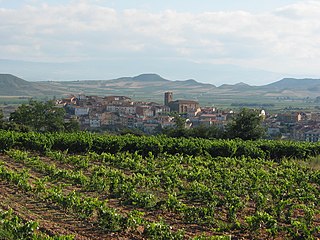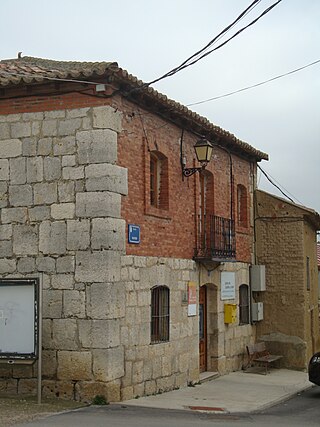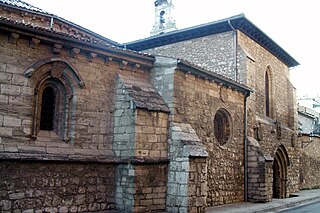
The Royal Sites are a set of palaces, monasteries, and convents built for and under the patronage of the Spanish monarchy. They are administered by Patrimonio Nacional (National Heritage), a Spanish state agency; most are open to the public, at least in part, except when they are needed for state or official events.

Tordesillas is a town and municipality in the province of Valladolid, Castile and León, central Spain. It is located 25 kilometres (16 mi) southwest of the provincial capital, Valladolid at an elevation of 704 metres (2,310 ft). The population was c. 8,760 as of 2021.

Monastery of Santa Clara or Convent of Santa Clara in Vila do Conde, Portugal was one of the biggest and richest feminine convents in Portugal, founded in 1318, by Afonso Sanches and his wife, Teresa Martins Telo.

Patrimonio Nacional is a Spanish autonomous agency, under the jurisdiction of the Ministry of the Presidency, Justice and Relations with the Cortes, that administers the sites owned by the Spanish State and used by the Monarch and the Spanish Royal Family as residences and for State Ceremonies. The Patrimonio Nacional includes palaces, gardens, monasteries and convents, called the Royal sites. When not in official use, the Royal sites are open to the public. It also manages the official and holiday residences of the Prime Minister.

Entrena is a municipality of La Rioja, (Spain), located near the capital Logroño. Its population in January 2010 was 1,503 over an area of 21.03 square kilometres. The nucleus is placed at an altitude of 558 metres. It is bordered by Navarrete and Lardero to the north; Albelda de Iregua to the east; Nalda, Sorzano and Sojuela to the south; and Medrano to the west.

The Abbey of Santa María la Real de Las Huelgas is a monastery of Cistercian nuns located approximately 1.5 km west of the city of Burgos in Spain. The word huelgas, which usually refers to "labour strikes" in modern Spanish, refers in this case to land which had been left fallow. Historically, the monastery has been the site of many weddings of royal families, both foreign and Spanish, including that of Edward I of England to Eleanor of Castile in 1254, for example. The defensive tower of the abbey is also the birthplace of King Peter of Castile.

Jerónima de la Asunción, O.S.C. was a Spanish Catholic nun and abbess who founded the Real Monasterio de Santa Clara in Intramuros, Manila, Philippines.

Villán de Tordesillas is a municipality located in the province of Valladolid, Castile and León, Spain. According to the 2004 census (INE), the municipality had a population of 176 inhabitants.

The Monastery of Santa Clara-a-Nova is a monastery in Coimbra, Portugal. It was built to replace the mediaeval Monastery of Santa Clara-a-Velha, located nearby, which at the time was prone to frequent flooding by the waters of the Mondego river. The monastery was built in the 17th and 18th centuries and is classified as a National Monument. It is located in the Santa Clara parish.

The Real Monasterio de la Encarnación is a convent of the order of Recollet Augustines located in Madrid, Spain. The institution mainly interned women from noble families, and was founded by the Queen Margaret of Austria, wife of Philip III, and thus was well endowed with wealth. Although it belongs to an enclosed religious order, the building is open to the public under the administration of the Patrimonio Nacional.

Dzidzantún Municipality is a municipality in the Mexican state of Yucatán containing 198.00 square kilometres (76.45 sq mi) of land and located roughly 75 kilometres (47 mi) northeast of the city of Mérida.

The Convento de San José is a monastery of Discalced Carmelite nuns in Ávila, Spain. It is situated not far from the center of the city but outside the medieval walls. Saint Teresa of Jesus was the driving force behind the foundation of the monastery, which was built from 1562 onwards. The church was only begun in 1607 after Saint Teresa's death. The statue in the facade was commissioned by King Philip III of Spain via artist Giraldo de Merlo.
St. Clare's Convent, St. Clare's Priory, Poor Clare's Convent, Convent of Santa Clara, or other variations on the name, may refer to:

Igreja de Santa Clara is a Catholic church located in the parish of Sé in Porto, Portugal.
The Royal Household and Heritage of the Crown of Spain was the institution that governed the organization of the Royal Spanish Court from the time of the Habsburg dynasty, which introduced the so-called Burgundian etiquette, up to the reign of Alfonso XIII, great-grandfather of the current King of Spain Felipe VI, in all that regarded the structure of the Court as well as the ceremonial matters, etiquette and protocol.

The Route of the Borgias is a cultural route, that includes sites associated with the Borja or Borgia, located in their native Valencian Community, Spain. The marketing of the route was inaugurated in 2007.

The Iglesia del Carmen de Burgos is a nun's convent in Burgos, Castile and León, Spain. It is situated on the corner of Calle de Covarrubias, del Progreso and Santa Clara. It is a Gothic edifice built mostly in the thirteenth century, at the time of its founding, when it was part of the Monasterio de Santa María la Real de Las Huelgas. It dates to 1234.

The Convento de Santa Clara la Real is a convent of the Poor Clares located in the city of Toledo, Castile-La Mancha, Spain. The present convent was founded in the middle of the 14th century by Toledan noblewoman María Meléndez, and is located near other monasteries of note, such as the monastery of Santo Domingo el Real and the Convent of Capuchins of Toledo.

Artesonado or Spanish ceiling is a term for "a type of intricately joined wooden ceiling in which supplementary laths are interlaced into the rafters supporting the roof to form decorative geometric patterns", found in Spanish architecture. It is an example of Mudéjar style.



















